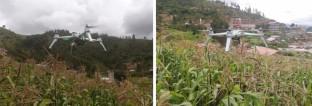Precision Agriculture ( IF 5.4 ) Pub Date : 2022-08-14 , DOI: 10.1007/s11119-022-09951-x Alfonso Antolínez García , Jorge W. Cáceres Campana

|
Maize is the second most plentiful cereal grown for human consumption. It constitutes 36% of total grain production worldwide and it is cultivated in about 160 countries on nearly 150 m ha. Maize faces fungal diseases causing extraordinary reduction in the grain yield. Fungi are responsible for many maize foliar diseases. Fungicides show hazardous effects on human health and also soil and water pollution. Near-infrared (NIR) images can disclose damage patterns not visible to the naked eye or depicted in RGB images. Unmanned aerial vehicles (UAV) are an inexpensive way to collect low altitude images. State-of-the-art Convolutional Neural Networks (CNN) have proven excellent results in image classification in computer vision. This study presents a novel Transfer Learning (TL) based CNN technique and states the hypothesis that NIR images acquired by UAVs contribute to a more precise classification of pathogens in maize. GPS coordinates of the infested areas are also provided for precision spraying with fungicide agents for specific targets, representing an economical mean for yield protection and with the least possible hazard to people and to the ecosystem. The proposed model was evaluated on its performance using different metrics achieving an accuracy of 86.7%, precision 98%, sensitivity 86.9% and F1 Score 92%. According to the state-of-the-art literature consulted, this is the first time that a validated deep learning-based approach has been applied in fungal diseases classification using infrared images.
中文翻译:

使用近红外无人机图像和深度学习识别玉米中的病原体
玉米是供人类食用的第二丰富的谷物。它占全球粮食总产量的 36%,在约 160 个国家种植,面积近 150 平方米。玉米面临导致粮食产量异常下降的真菌病害。真菌是导致许多玉米叶面病害的原因。杀菌剂对人类健康以及土壤和水污染显示出有害影响。近红外 (NIR) 图像可以揭示肉眼不可见或在 RGB 图像中描绘的损坏模式。无人机 (UAV) 是一种廉价的低空图像采集方式。最先进的卷积神经网络 (CNN) 在计算机视觉中的图像分类中已经证明了出色的结果。本研究提出了一种新的基于转移学习 (TL) 的 CNN 技术,并提出了这样的假设,即无人机获取的 NIR 图像有助于更精确地分类玉米中的病原体。还提供了受侵染区域的 GPS 坐标,用于针对特定目标使用杀真菌剂进行精确喷洒,这是一种经济的产量保护手段,对人类和生态系统的危害最小。所提出的模型使用不同的指标对其性能进行了评估,准确度为 86.7%,精度为 98%,灵敏度为 86.9%,F1 分数为 92%。根据查阅的最新文献,这是首次将经过验证的基于深度学习的方法应用于使用红外图像进行真菌疾病分类。











































 京公网安备 11010802027423号
京公网安备 11010802027423号